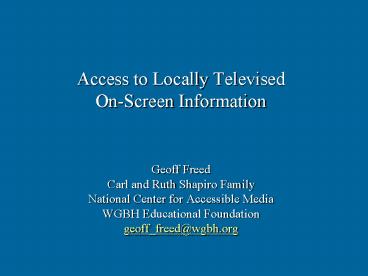Access to Locally Televised On-Screen Information - PowerPoint PPT Presentation
Title:
Access to Locally Televised On-Screen Information
Description:
Emergency information that is provided in the audio portion of the programming ... recommendations for further study. Additional work in accessible alerts ... – PowerPoint PPT presentation
Number of Views:14
Avg rating:3.0/5.0
Title: Access to Locally Televised On-Screen Information
1
Access to Locally Televised On-Screen
Information
- Geoff Freed
- Carl and Ruth Shapiro Family
- National Center for Accessible Media
- WGBH Educational Foundation
- geoff_freed_at_wgbh.org
2
About NCAM
- The Media Access Group at WGBH is a non-profit
service (offices in Boston and Los Angeles) - The Caption Center (est. 1972)
- the world's first captioning agency
- makes audiovisual media accessible to audiences
who are deaf or hard-of-hearing - Descriptive Video Service (est. 1990)
- makes television, film video accessible to
audiences who are blind or visually impaired - The National Center for Accessible Media (est.
1993) - a research, development and advocacy entity
- works to make existing emerging technologies
accessible to all audiences - digital television, convergent media, educational
technologies, web, multimedia
3
Access to Locally Televised On-Screen Information
- October 2005 September 2008 extended until
September 2009 http//ncam.wgbh.org/onscreen - Exploring solutions to enable local television
stations to convey both emergency and
non-emergency information in a manner that meets
the communication needs of people with sensory
disabilities. - Funding provided by the U.S. Department of
Education - Partner television station WCVB Hearst-Argyle
4
Project Activities
- Develop prototype software to intercept data from
various sources, then extract, transform and
prepare it for text display or for speech output.
- Create demonstration models.
- Publish guidelines for local television stations
which suggest implementation schemes for various
equipment configurations, and provide
recommendations for further study.
5
Rules regarding accessibility of on-screen
information
- FCC 47 C.F.R. Part 79, established in 2000
- Emergency information that is provided in the
audio portion of the programming must be made
accessible to persons with hearing disabilities
by using a method of closed captioning or by
using a method of visual presentation. - Emergency information that is provided in the
video portion of a regularly scheduled newscast,
or newscast that interrupts regular programming,
must be made accessible to persons with visual
disabilities.
6
Rules regarding accessibility of on-screen
information
- Emergency information that is provided in the
video portion of programming that is not a
regularly scheduled newscast, or a newscast that
interrupts regular programming, must be
accompanied with an aural tone. - Emergency information should not block any closed
captioning and any closed captioning should not
block any emergency information provided by means
other than closed captioning.
7
Rules regarding accessibility of on-screen
information
- Emergency information should not block any video
description and any video description provided
should not block any emergency information
provided by means other than video description.
8
Examples of current practice
9
Examples of current practice
10
Solutions descriptions
- Analog One stream of additional audio inserted
into the SAP channel.
11
Solutions descriptions
- Multiple streams of information
12
How its done TTS
13
Solutions captions
- Relocate captions as necessary
- software that monitors position of on-screen
graphics so that captions may be automatically
relocated when there is a conflict between the
two elements
14
Solutions relocatable captions (lower-third)
15
Solutions relocatable captions (upper-third)
16
How its done captions
- Application monitors a scene open in DekoCast
- Controls GPI outputs to control an EEG CB412
Caption Data Bridge - CB412 is used to relocate closed caption text
away from lines where it would obscure the
graphics underneath
17
How its done captions
18
Guidelines
- Publication of guidelines for local stations that
summarize... - how software can be used to prepare data for
translation to speech, and inserted into the
broadcast stream - suggestions for an array of implementation
schemes for various equipment configurations - recommendations for further study.
19
Additional work in accessible alerts
- Access to Emergency Alerts, 4-year grant from
U.S. Dept. of Commerce http//ncam.wgbh.org/alert
s - United industry and consumers to identify
replicable approaches to accessible notification
- Resources include
- Information requirements model
- Consumer, emergency management social science
research reports - Recommendations to media, government, industry,
emergency management and consumers
20
Excerpted recommendations to media
- Produce a library of fully accessible (text,
audio, video) emergency messages that can be
delivered on-air, via mobile devices, the Web,
shown in shelters, etc. - Instruct on-air news personnel to audibly
describe what is visually presented (e.g., maps,
remote broadcasts, etc.) - Provide captions audio descriptions for video
delivered on the Web - Ensure that broadcasters Web sites are fully
accessible
21
Access to Locally TelevisedOn-Screen Information
- Geoff Freed
- geoff_freed_at_wgbh.org
- http//ncam.wgbh.org/onscreen

